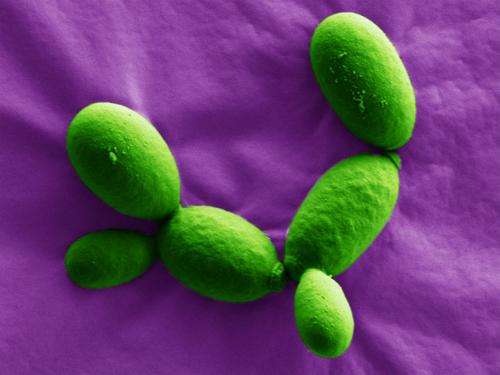New yeast species marks milestone

The National Collection of Yeast Cultures at the Institute of Food Research has added the 4,000th yeast strain to its publicly-available collection.
'NCYC 4000' was found at the bottom of a collapsed magma chamber on Santa Cruz, one of the Galápagos Islands. It was growing on rotten wood collected from a species of tree unique to the Galápagos archipelago, known locally as the daisy tree.
The yeast was discovered by Professor Javier Carvajal and his team from the Colección de Levaduras Quito Católica (CLQCA) at the Pontificia Universidad Católica del Ecuador, who have had a longstanding collaboration with the NCYC team. Javier sent the yeast to the NCYC in Norwich for analysis and identification. NCYC is funded by the Biotechnology and Biological Sciences Research Council as a National Capability, to help make its expertise and resources widely available to academics and industry.
By analysing different portions of the yeast's genome, Dr Steve James found that 'NCYC 4000' was similar to other strains of yeast, which had been found at a number of sites in the Yasuní National Park in Ecuador. These strains have now been identified as a novel species, and given the name Kazachstania yasuniensis.
The Yasuní National Park has been identified as one of the most biodiverse spots on the planet, and the new yeast species extends this biodiversity to cover the microbial world.
"Research and development of new technologies has experienced an evolution during the last few years in Ecuador. The fact that we are now able to characterize and catalogue our biodiversity provides us with new and promising sources for innovation towards sustainable development within the bioeconomy framework," said René Ramírez, Secretary of Higher Education Science and Technology and Innovation of Ecuador.
"In this context, the finding of the new yeast species in Ecuadorian territory by the binational Anglo-Ecuadorian team of researchers, as well as other yeast species recently described from Ecuador by the same team, constitutes not only a highly valuable resource for a future biotechnological exploitation, but a clear symptom of the development of the science in the country"
Expanding the yeast gene pool
The NCYC team regard biodiversity in yeast as a valuable resource for the development of new biotechnologies that could help combat some of the challenges facing the planet. Yeasts could hold the key to innovative ways of generating sustainable fuels or other chemicals that currently rely on petrochemicals. The fermentative ability of yeast varies markedly from species to species; some work on different starting materials, while others are specialised to work in different environmental conditions. NCYC is continually adding diverse yeast strains to its collections.
Renewable chemicals
NCYC, working with colleagues in the Biorefinery Centre at IFR, are currently screening their entire collection of yeasts to characterise those that show the most promise for future developments.
As Dr Ian Roberts, research leader of the NCYC points out, "We don't know what tricks this new species might be hiding up its sleeve, but the more we can find out about what yeasts can do, the closer we get to harnessing their abilities and developing cleaner, greener technologies for the future."
The National Collection of Yeast Cultures came into existence over 65 years ago, originally set up to preserve breweries' yeast strains. Some beers are brewed with characteristic yeast strains, so if that yeast became contaminated or lost, then the brewer risks not being able to brew that exact same beer. NCYC stores samples of these yeasts, preserved by freezing, and continues to provide this service to the brewing industry today, even helping to revive beers lost to the world many years after the original breweries had closed.
Yeast has also become an important tool for scientists to study fundamental processes that happen in living cells, so NCYC has also taken on a role in providing authenticated yeast strains to the academic community. And their expertise in yeast has been invaluable in helping industry identify potential contaminants and dealing with them.
More information: Kazachstania yasuniensis sp. nov., a novel ascomycetous yeast species found in mainland Ecuador and on the Galápagos, James, S. A. et al International Journal of Systemic and Evolutionary Microbiology, DOI: 10.1099/ijs.0.000102
Provided by Norwich BioScience Institutes


















